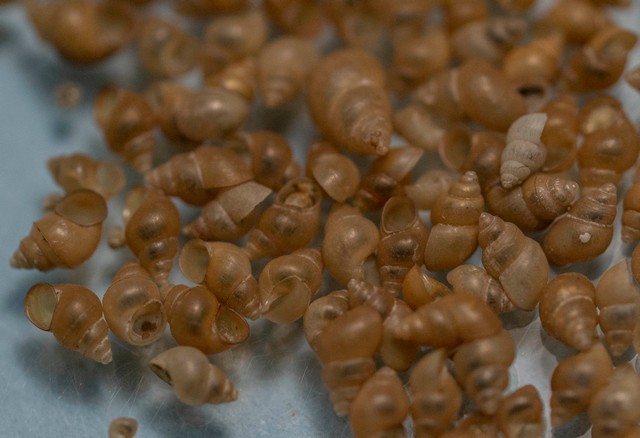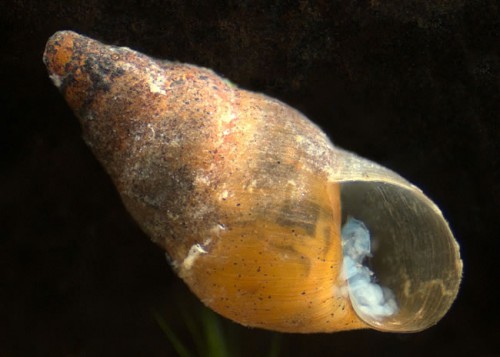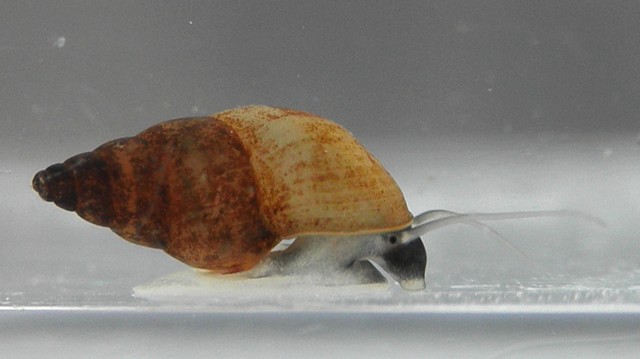New Zealand Mud Snail
(Potamopyrgus antipodarum)
Learn about the New Zealand Mud Snail, including their identifying features, distribution, habitat, spread, similar species, impacts and our response.
On this page

The New Zealand Mud Snail is a mollusc part of the gastropods.
Identifying features
- between 0.5 cm and 0.7 cm in size
- thin shell that varies in shape, with 5 to 7 whorls winding clockwise, separated by deep sutures;
- colour varies from light to dark brown.
If you think you have seen a New Zealand Mud Snail, report it.
Where is the species invasive
First reported in Lake Ontario and the St. Lawrence River in 1991, the New Zealand Mud Snail is said to have been illegally introduced to North America by the aquarium trade. After their introduction, these snails were spread by water gardens, maritime traffic, watersports and recreational fishing.
Distribution
The New Zealand Mud Snail comes from New Zealand and its surrounding islands.
Habitat
The New Zealand Mud Snail lives in ponds, marshes, rivers, lakes, and irrigation canals where the bottom is covered with silt, clay, sand, gravel, or large algae. This snail lives mainly near the shore, but it can survive up to 25 m of depth.
Similar species
Several other species of freshwater snails are native to Canada so experts are often needed to differentiate them. The New Zealand Mud Snail resembles the Common Mud Snail (Potamopyrgus estuarinus) and Potamopyrgus pupoides, but these species of snails live in brackish water.
Common Mud Snail

Impacts
Ecological impacts
In areas where it is introduced, the New Zealand Mud Snail competes with native species for food and territory. Its success is linked to its very high fertility and its ability to reproduce asexually. Thus, a single female is enough to establish a new colony. In addition, the New Zealand Mud Snail has low predation rates and tolerates a wide temperature range and brackish waters. Once established, it can reach densities of around 300,000 individuals/square meter. Under these conditions, it can represent up to 97% of the invertebrate biomass in its environment and becomes practically impossible to eradicate.
Socio-economics impacts
The establishment of the New Zealand Mud Snail could have an impact on recreational, Indigenous and commercial fisheries.
Response
The Identification Booklet of Freshwater Invasive Species in Quebec from DFO is available to make the detection of the New Zealand Mud Snail easier.
The best way to protect water bodies is water from this invader is to properly clean, drain and dry boats and other equipment used in nautical activities and recreational fishing. It is also important to prevent the deliberate and accidental release of specimens into the environment like lakes or rivers. Don't let it loose and follow the clean-up steps described on the DFO Aquatic Invasive Species Prevention page. Always check and follow provincial regulations when planning to move water-based craft and equipment.
Photo gallery

Related links
- New Zealand Mud Snail identification photos and characteristics
- Science Advice on "Clean, Drain, Dry and Decontaminate" treatments and protocols to prevent the introduction and spread of aquatic invasive species (PDF, 632 KB)
- Research Document on "Clean, Drain, Dry, and Decontaminate" treatments and protocols to prevent the introduction and spread of aquatic invasive species
- Science Advice on the Potential of Introducing Live Organisms by the Aquarium, Water Garden, and Live Food Trades in Canada (PDF, 1192 KB)
- Date modified: